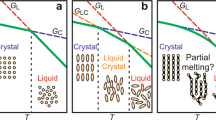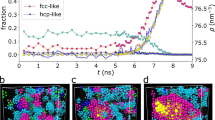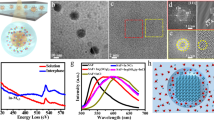Abstract
Phase transitions occur when the chemical potentials (including bulk and interfacial contributions) of two phases are equal. For systems with large interfaces, such as thin films or small particles, their interfacial properties strongly affect the phase behaviour. This dependence is important in fundamental and applied science (sintering, nucleation) but many details are still poorly understood owing to the scarcity of quantitative experimental data. Here, we use solid alkane domains that are one monolayer thick and deposited on a substrate to investigate and quantify the influence of the interface on the solid–liquid phase transition. The domains melt gradually below the bulk melting point of alkane. They coexist with a ‘pre-molten’ liquid-like film of variable temperature-dependent thickness. Molecules interchange reversibly between film and domains, thereby converting transition enthalpy into interfacial energy. (Thus, we obtain details of the intermolecular interactions within the adjacent film.) We show that irrespective of its dimensionality or confinement, every solid will melt (partially) and spread out at temperatures below its bulk melting point if its liquid wets the adjoining interface.
This is a preview of subscription content, access via your institution
Access options
Subscribe to this journal
Receive 12 print issues and online access
$209.00 per year
only $17.42 per issue
Buy this article
- Purchase on Springer Link
- Instant access to full article PDF
Prices may be subject to local taxes which are calculated during checkout




Similar content being viewed by others
References
Wautelet, M. Scaling laws in the macro-, micro- and nanoworlds. Eur. J. Phys. 22, 601–611 (2001).
Efremov, M. Y., Olson, E. A., Zhang, M., Zhang, Z. & Allen, L. H. Glass transition in ultrathin polymer films: Calorimetric study. Phys. Rev. Lett. 91, 085703 (2003).
Hutcheson, S. A. & Mckenna, G. B. Nanosphere embedding into polymer surfaces: A viscoelastic contact mechanics analysis. Phys. Rev. Lett. 94, 189902 (2005).
Cacciuto, A., Auer, S. & Frenkel, D. Onset of heterogeneous crystal nucleation in colloidal suspensions. Nature 428, 404–406 (2004).
Davey, R. J. Crystallization—How come you look so good? Nature 428, 374–375 (2004).
Campbell, C. T., Parker, S. C. & Starr, D. E. The effect of size-dependent nanoparticle energetics on catalyst sintering. Science 298, 811–814 (2002).
Lazar, P. & Riegler, H. Reversible self-propelled droplet movement: A new driving mechanism. Phys. Rev. Lett. 95, 136103 (2005).
Lazar, P., Schollmeyer, H. & Riegler, H. Spreading and two-dimensional mobility of long-chain alkanes at solid/gas interfaces. Phys. Rev. Lett. 94, 116101 (2005).
Merkl, C., Pfohl, T. & Riegler, H. Influence of the molecular ordering on the wetting of SiO2/air interfaces by alkanes. Phys. Rev. Lett. 79, 4625–4628 (1997).
Schollmeyer, H., Struth, B. & Riegler, H. Long chain n-alkanes at SiO2/air interfaces: Molecular ordering, annealing, and surface freezing of triacontane in the case of excess and submonolayer coverage. Langmuir 19, 5042–5051 (2003).
Kohler, R., Lazar, P. & Riegler, H. Optical imaging of thin films with molecular depth resolution. Appl. Phys. Lett. 89, 241906 (2006).
Israelachvili, J. N. Intermolecular and Surface Forces (Academic, London, 1992).
Adamson, A. Physical Chemistry of Surfaces (Wiley, New York, 1990).
Dirand, M. et al. Temperatures and enthalpies of (solid plus solid) and (solid plus liquid) transitions of n-alkanes. J. Chem. Thermodyn. 34, 1255–1277 (2002).
Wilen, L. A., Wettlaufer, J. S., Elbaum, M. & Schick, M. Dispersion-force effects in interfacial premelting of ice. Phys. Rev. B 52, 12426–12433 (1995).
Widom, B. What do we know that van der Waals did not know? Physica A 263, 500–515 (1999).
Wettlaufer, J. S. & Dash, J. G. Melting below zero. Sci. Am. 282, 50–53 (2000).
Dash, J. G. History of the search for continuous melting. Rev. Mod. Phys. 71, 1737–1743 (1999).
Dash, J. G., Rempel, A. W. & Wettlaufer, J. S. The physics of premelted ice and its geophysical consequences. Rev. Mod. Phys. 78, 695–741 (2006).
Wettlaufer, J. S. & Worster, M. G. Premelting dynamics. Annu. Rev. Fluid Mech. 38, 427–452 (2006).
Zhuravlev, L. T. The surface chemistry of amorphous silica. Zhuravlev model. Colloids Surf. A 173, 1–38 (2000).
Graf, K. & Riegler, H. Molecular adhesion interactions between Langmuir monolayers and solid substrates. Colloids Surf. A 131, 215–224 (1998).
Holzwarth, A., Leporatti, S. & Riegler, H. Molecular ordering and domain morphology of molecularly thin triacontane films at SiO2/air interfaces. Europhys. Lett. 52, 653–659 (2000).
Knufing, L., Schollmeyer, H., Riegler, H. & Mecke, K. Fractal analysis methods for solid alkane monolayer domains at SiO2/air interfaces. Langmuir 21, 992–1000 (2005).
Schollmeyer, H., Ocko, B. & Riegler, H. Surface freezing of triacontane at SiOx/air interfaces: Submonolayer coverage. Langmuir 18, 4351–4355 (2002).
Acknowledgements
We thank H. Moehwald for supporting this research, A. Heilig for the preparation of the alkane stock solutions and H. Wetzel from the Fraunhofer Institut fuer Angewandte Polymerforschung (Potsdam) for checking the purity of the alkanes.
Author information
Authors and Affiliations
Corresponding author
Supplementary information
Rights and permissions
About this article
Cite this article
Riegler, H., Köhler, R. How pre-melting on surrounding interfaces broadens solid–liquid phase transitions. Nature Phys 3, 890–894 (2007). https://doi.org/10.1038/nphys754
Received:
Accepted:
Published:
Issue Date:
DOI: https://doi.org/10.1038/nphys754



